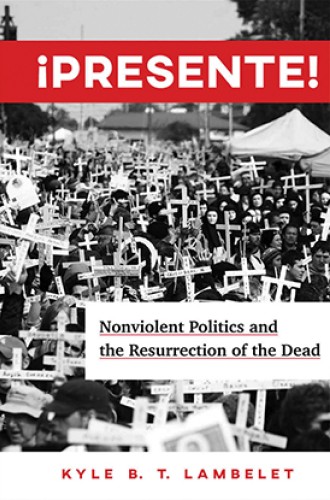Messianic protest against the School of the Americas
In Kyle Lambelet’s view, SOA Watch demonstrates the virtues of a messianic politics.
When I signed up to protest with the SOA Watch in 2005, I had only a vague idea what the School of the Americas was. I had started teaching at a bilingual Jesuit high school on Chicago’s near southwest side, and a few weeks into the job a colleague asked me if I would be willing to be the second chaperone on a trip he was planning to the annual vigil at Fort Benning. Feeling up for an adventure, I agreed to come along. That November, the two of us and a dozen or so Latinx teenagers piled into a passenger van and made the 12-hour trek to Columbus, Georgia.
As it turns out, Kyle B. T. Lambelet participated in that same 2005 vigil. For him, it was the first of many. ¡Presente! Nonviolent Politics and the Resurrection of the Dead reflects both Lambelet’s theology and his commitments as a participant-observer in the SOA Watch movement.
Read our latest issue or browse back issues.
The origins of the SOA extend back to the immediate post–World War II years, when the United States Army founded a military training institute in the Panama Canal Zone. Throughout the Cold War the SOA instructed Latin American cadets in a variety of advanced counterinsurgency techniques, ranging from covert jungle warfare to blackmail, assassination, and torture. Military personnel trained at the SOA went on to participate in the oppression and murder of civilians back home in Argentina, Bolivia, Chile, El Salvador, Guatemala, and other countries. Among the hundreds of thousands killed in the 1980s alone were the now-sainted archbishop of San Salvador Óscar Romero and six Jesuit priests.
In Lambelet’s view, the movement to close the SOA demonstrates the virtues of a messianic politics. While political theologians and social ethicists have often criticized messianism—defined here in terms of “the Christian theological affirmation that the crucified and resurrected Jesus is sovereign over history”—as a gateway to either “extremist violence” or “quietist withdrawal,” Lambelet sees more constructive possibilities. He argues that “the messianic affirmation of the presence of the dead not only can evade each of these problems but also can generate a nonviolent politics rooted in distinctive forms of practical reasoning.”
For Lambelet, the proof is in the proverbial pudding. After all, the movement’s provocative insistence that the dead are presente (Spanish for “here” or “present”) has in fact produced neither violence nor quiescence but rather an enduring solidarity. As he movingly writes, “faithfulness to the ‘dangerous memories’ of the crucified people—memories of those who were meant to be forgotten, such as the villagers of El Mozote, or those who were meant to be silenced, such as Óscar Romero and Ignacio Ellacuría—demands not only memory but resistance.”
The fact that the best means and mechanisms of resistance have been hotly debated within the SOA Watch movement only further underscores, for Lambelet, the compatibility of messianic politics and pluralistic democracy. The faith at the heart of the movement requires a resort to practical reasoning, for as he points out, “though the dead are active . . . they do not tell SOA Watch participants what to do next.” While participants’ political intuitions run the gamut from reform to revolution, they continue to come together year after year around a shared commitment to nonviolence.
Many of my recollections of the 2005 trip have grown hazy, but particular scenes are seared into my memory. The outdoor evening mass featuring Sister Helen Prejean (of Dead Man Walking fame)—who repeatedly proclaimed, “We must build the Kingdom on earth”—and which culminated with a diverse congregation of people from all over the country receiving the Eucharist while singing “Somos el cuerpo de Cristo” (We are the body of Christ). The slick presentation by official representatives of the Western Hemisphere Institute for Security Cooperation (WHINSEC)—the agency that arose at Fort Benning immediately after the SOA closed (in name only, as many activists saw it) in 2000—touting their unwavering commitment to human rights. A massive throng of some 20,000 persons solemnly processing while chanting “¡Presente!” as the names of those murdered in Latin America were read out, one by one. Having come to Fort Benning with my political and theological outlook already in major flux, I left challenged, disoriented, and brimming with new questions.
¡Presente! is written first and foremost with an academic audience in mind. But I hope Lambelet will discover ways to bring the book’s many insights to a wider readership. In the last generation and especially on the left, there has been a tendency to minimize religious particularity in public campaigns (which is understandable, given the nation’s changing demographics). Pastors, laypersons, and secular activists alike will therefore be interested in Lambelet’s contention that Christian convictions about the resurrection of the dead might still leaven movements for justice in an increasingly post-Christian United States.
Even more timely in our current moment is Lambelet’s suggestion that the choice between faithful witness and political effectiveness is a false one. The movement to close the SOA has cultivated radical dreams of a day, coming soon, when death and oppression shall be no more, even as it has fought tooth and nail in the halls of Congress and well beyond for incremental gains. Revolutionaries and reformers often regard one another as enemies, but in these troubled days—as our virus-stricken nation grapples with spiraling inequality and death-dealing racism—might their clashes function like iron sharpening iron? For the sake of the living and the dead, one can certainly hope.







